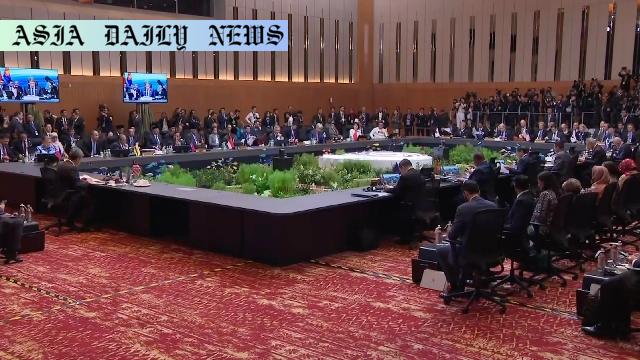East Asia Summit, hosted by Malaysia, addressed global trade tensions, regional stability, and economic uncertainties.
- Key Point 1: Foreign ministers from ASEAN and regional powers converged for the East Asia Summit in Kuala Lumpur.
- Key Point 2: The summit highlighted concerns over rising global trade tensions and regional economic uncertainties.
- Key Point 3: Discussions also addressed geopolitical issues, including Beijing’s influence in the South China Sea and the Russia-Ukraine conflict.

Threats to Global Trade Take Center Stage
The East Asia Summit, held in Kuala Lumpur under Malaysia’s ASEAN chairmanship, brought together foreign ministers from major nations such as the US, Japan, China, and Russia to deliberate crucial global challenges. This year’s discussions were heavily influenced by concerns over rising trade tensions and a shifting economic landscape. Malaysia’s Foreign Minister, Mohamad Hasan, set the tone in his opening remarks, emphasizing the urgent need for enhanced coordination amidst a globally complex web of crises jeopardizing peace, prosperity, and people’s well-being.
Trade uncertainties, a central focus of the discussion, were underscored by a draft chairman’s statement that highlighted shared apprehensions among member states. Despite such unity on general trade concerns, sources revealed there was no explicit discussion concerning the controversial US tariff policies. Nonetheless, the summit’s messaging on the need for more trade stability served as a reminder of the mounting pressures faced by East Asian economies, especially amid the post-pandemic recovery phase.
Addressing the South China Sea and Other Geopolitical Issues
Another major topic of the summit revolved around Beijing’s assertive presence in the South China Sea. This long-standing issue continues to be a flashpoint in regional relations, with China’s growing dominance from an economic and strategic perspective challenging neighboring nations. The summit also provided a platform for smaller Southeast Asian countries to voice their concerns and call for cooperative solutions to ensure regional stability.
Adding to the complexity of the conversations was Russia’s invasion of Ukraine, which has ruffled global energy markets and introduced fresh challenges to worldwide peace and stability. Though not a Southeast Asian issue directly, the presence of Russia at the summit underlined the region’s interconnected nature in global diplomatic and economic networks.
The Importance of Multilateral Dialogues in Solving Complex Crises
The East Asia Summit underscored the vital role that multilateral dialogues play in addressing shared challenges across nations. Despite lingering political rivalries, high-level gatherings such as this offer countries an opportunity to find common ground on issues of economic or geopolitical concern. Malaysia’s leadership as summit chair was particularly highlighted through calls to action focused on fostering prosperity and ensuring peace.
In what has often been a polarized global environment, these meetings may lack immediate solutions but serve as a foundation for long-term strategies. Platforms like the East Asia Summit reaffirm the critical utility of diplomacy during crises, especially in an era marked by economic volatility, environmental challenges, and geopolitical complexities.



Commentary
The Role of Regional Dialogues in Tackling Global Challenges
The East Asia Summit serves as a key example of how regional platforms can bring a sense of cohesion amid growing disarray in the international order. The meeting in Kuala Lumpur highlighted the vital role such summits play in fostering cooperation and understanding, even between countries that may have historical or political tensions. This regional dialogue’s focus on critical trade concerns and economic uncertainty underscores its importance as more than a ceremonial event.
The Timeliness of Discussing Trade and Stability
Trade tensions remain a persistent theme in dialogues across the globe, and the East Asia Summit presents a fitting forum for Asia-Pacific nations to address these challenges head-on. What was particularly significant in this year’s summit was its concerted effort to emphasize shared prosperity rather than focusing on divisive rhetoric. Indeed, addressing the broader issue of trade imbalances requires more collaboration than confrontation.
The Power of Unity in Solving Regional Conflicts
While the presence of dominant nations like China and Russia adds complexity to the debate, smaller ASEAN member nations also make their voices heard in these summits. The focus on the South China Sea exemplifies the delicate tightrope ASEAN countries walk. This summit reminds us that diplomacy remains our best option for managing sensitive disputes while cultivating larger-scale stability.
Together, dialogues like the East Asia Summit offer hope that regional unity and mutual collaboration will triumph over fractured global relations. In an increasingly interconnected world, forums like these are more critical than ever.